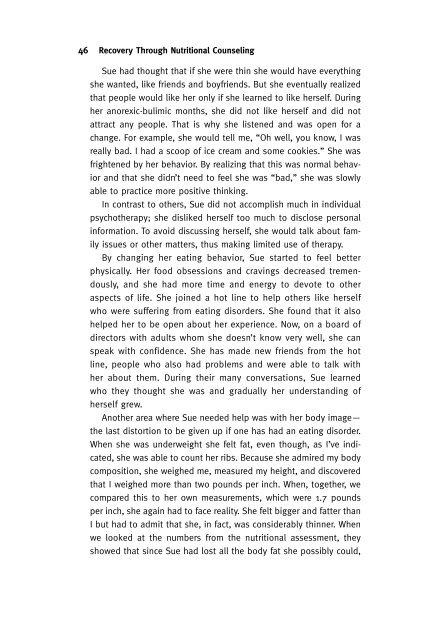Eating Disorders - fieldi
Eating Disorders - fieldi
Eating Disorders - fieldi
You also want an ePaper? Increase the reach of your titles
YUMPU automatically turns print PDFs into web optimized ePapers that Google loves.
46 Recovery Through Nutritional Counseling<br />
Sue had thought that if she were thin she would have everything<br />
she wanted, like friends and boyfriends. But she eventually realized<br />
that people would like her only if she learned to like herself. During<br />
her anorexic-bulimic months, she did not like herself and did not<br />
attract any people. That is why she listened and was open for a<br />
change. For example, she would tell me, “Oh well, you know, I was<br />
really bad. I had a scoop of ice cream and some cookies.” She was<br />
frightened by her behavior. By realizing that this was normal behavior<br />
and that she didn’t need to feel she was “bad,” she was slowly<br />
able to practice more positive thinking.<br />
In contrast to others, Sue did not accomplish much in individual<br />
psychotherapy; she disliked herself too much to disclose personal<br />
information. To avoid discussing herself, she would talk about family<br />
issues or other matters, thus making limited use of therapy.<br />
By changing her eating behavior, Sue started to feel better<br />
physically. Her food obsessions and cravings decreased tremendously,<br />
and she had more time and energy to devote to other<br />
aspects of life. She joined a hot line to help others like herself<br />
who were suffering from eating disorders. She found that it also<br />
helped her to be open about her experience. Now, on a board of<br />
directors with adults whom she doesn’t know very well, she can<br />
speak with confidence. She has made new friends from the hot<br />
line, people who also had problems and were able to talk with<br />
her about them. During their many conversations, Sue learned<br />
who they thought she was and gradually her understanding of<br />
herself grew.<br />
Another area where Sue needed help was with her body image—<br />
the last distortion to be given up if one has had an eating disorder.<br />
When she was underweight she felt fat, even though, as I’ve indicated,<br />
she was able to count her ribs. Because she admired my body<br />
composition, she weighed me, measured my height, and discovered<br />
that I weighed more than two pounds per inch. When, together, we<br />
compared this to her own measurements, which were 1.7 pounds<br />
per inch, she again had to face reality. She felt bigger and fatter than<br />
I but had to admit that she, in fact, was considerably thinner. When<br />
we looked at the numbers from the nutritional assessment, they<br />
showed that since Sue had lost all the body fat she possibly could,









